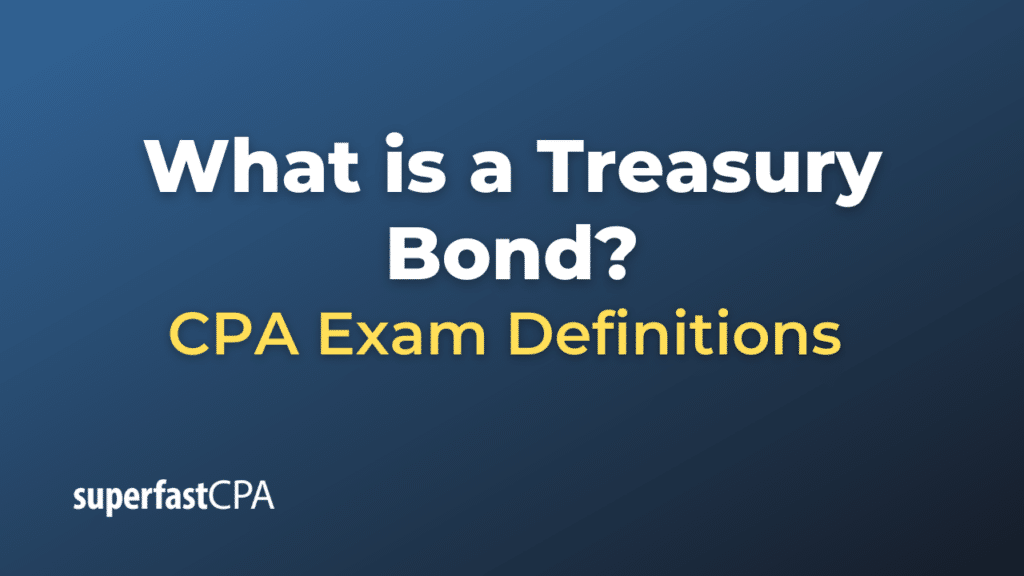Treasury Bond
A Treasury Bond (often abbreviated as T-Bond) is a long-term debt security issued by the U.S. government. These bonds are used by the government to raise funds for various public projects and to finance the national debt. Treasury Bonds are considered to be one of the safest investments because they are backed by the full faith and credit of the U.S. government.
Here are some key characteristics of Treasury Bonds:
- Maturity : Treasury Bonds have longer maturities compared to other Treasury securities like T-Bills or Treasury Notes. T-Bonds are typically issued with maturities ranging from 20 to 30 years.
- Interest Payments : Unlike T-Bills, T-Bonds do pay periodic interest. They pay semi-annual interest to bondholders, which is also called the “coupon payment.” The interest rate is fixed and determined at the time of issuance.
- Face Value: Like other bonds, T-Bonds have a face value (often $1,000). Upon maturity, the U.S. government will pay back this face value to the bondholder, in addition to the semi-annual interest payments during the bond’s life.
- Safety: Being backed by the U.S. government, T-Bonds are deemed to be among the safest investments available. This high degree of safety often translates to a lower yield compared to more risky assets.
- Liquidity: T-Bonds are highly liquid, meaning they can easily be sold in secondary markets before maturity if the investor wishes to cash out.
- Tax Considerations: The interest income from T-Bonds is exempt from state and local taxes. However, it is subject to federal income tax.
- Purchase and Trading: Investors can buy T-Bonds through the U.S. Department of the Treasury’s auction system (TreasuryDirect) or on the secondary market via financial institutions. They can be held or traded until maturity.
- Yield to Maturity (YTM): The yield to maturity is the total return that an investor would receive if the bond is held until it matures. It takes into account the bond’s current market price, face value, coupon interest rate, and the number of years remaining until maturity.
Treasury Bonds are a popular choice for investors seeking a long-term, risk-free investment that provides regular interest income. They are especially attractive during uncertain economic times or when other markets are volatile, as they provide stability and certainty.
Example of a Treasury Bond
Let’s delve into a hypothetical example to better understand how a Treasury Bond (T-Bond) operates:
Scenario: Investing in a 30-year Treasury Bond
Imagine you’re approaching retirement and are looking for a safe, long-term investment that provides regular income. After evaluating your options, you decide to invest in a 30-year T-Bond.
T-Bond Details:
- Face Value: $10,000
- Coupon Rate (interest rate) : 3% per annum
- Maturity: 30 years
1. Interest Payments:
- The T-Bond pays interest semi-annually, so you will receive interest payments twice a year.
- Your annual interest would be: 3% of $10,000 = $300.
- Semi-annual interest would be: $300 ÷ 2 = $150.
- This means every 6 months, you’ll receive $150, and $300 annually for the next 30 years.
2. Maturity:
- After 30 years, the T-Bond matures.
- In addition to your semi-annual interest payment, you will also receive back the bond’s face value of $10,000 from the U.S. government.
3. Total Returns:
- Over 30 years, you would receive a total of: 30 years × $300/year = $9,000 in interest payments.
- Adding the original principal/face value amount: $9,000 + $10,000 = $19,000.
- This means over the 30-year period, your initial $10,000 investment would yield a total of $19,000.
Selling Before Maturity:
Suppose 15 years later, interest rates in the market have fallen, and newer T-Bonds are being issued at a 2% coupon rate. Because your bond has a higher rate (3%), it becomes more valuable in the secondary market.
- If you decide to sell your T-Bond now, you might get a premium over its face value due to the higher coupon rate, thereby realizing a capital gain in addition to the interest payments you’ve received over the 15 years.
This example showcases the dual benefit of a T-Bond: consistent, predictable interest income, and the return of the principal amount upon maturity. Additionally, bonds can also provide capital gains (or losses) if sold in the secondary market before maturity, depending on prevailing interest rates and market conditions.













